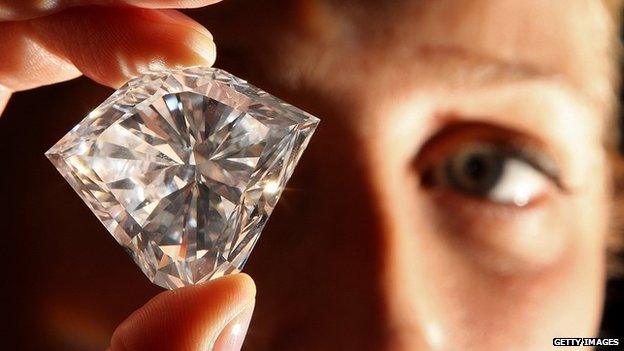Hatton Garden raid: The secrets of London's diamond quarter
- Published

Hatton Garden is home to a hidden world of precious-gem dealers and diamond merchants
It sounds like the screenplay from a heist movie.
Burglars break into a vault filled with diamonds, watches and priceless family heirlooms and take their pick from the hundreds of safe deposit boxes inside while no-one outside is any the wiser.
The row of unassuming shops and traders that make up London's jewellery quarter in the area known as Hatton Garden have long been the subject of secretive and seductive stories about underground passageways leading to gold stores and highly secure workshops where precious items are meticulously crafted by hand.
But with such a closed network of family businesses rarely opened up for outsiders to see it's difficult to find out how many of the stories are true.
'Trusted trade'
Hatton Garden's reputation for diamond dealing initially came about at the end of the 19th Century when De Beers began selling their South African stones through London.
The Hatton Garden area encompasses a small number of streets in Holborn surrounding the street of the same name. In an area covering roughly a tenth of a square mile, there are 300 shops and companies, including dealers, suppliers and craftsmen.
Joanna Hardy, an independent jewellery expert, who worked in Hatton Garden for over 20 years, is reluctant to confirm any of the myths or rumours because she says it goes against what the industry is all about.
"It's not so much a secret, it's that this is a trade that is built on trust.
"People think that it's all about top secret stuff but it's because of the high value of the goods that make it a very closed community. The people who work there have been doing it for generations and when something like this happens it shocks everybody."

Former detective Peter Kirkham says stolen high value jewellery is rarely recovered
'Old school crime'
The way the thieves have targeted the Hatton Garden Safe Deposit company only seems to add to the mystery.
"You don't see people holding up banks now, these crimes are done online behind a computer, but this seems all the more shocking because it's so old-school," Ms Hardy says.
And with so much gold and so many precious gems contained in the row of East London buildings, most people would assume security is high, with alarms, double door entry systems and CCTV on every exit.
But Peter Kirkham, a former detective chief inspector of the Metropolitan Police's specialist Flying Squad, says it's best not to assume.
"There is a huge amount of difference in the way premises are protected.
"From my experience this trade can actually be very complacent and think it just won't happen to them.
"It's not unheard of for thieves to trigger the system, wait for the response and then act when it's thought [by others] it was just a false alarm.
"If it is the case that there weren't strong security systems and procedures in place, thieves could have had the run of the place all weekend. There is just something that feels very odd about it all."
In whatever way the raid was carried out, Mr Kirkham says the chances of high value pieces being recovered isn't high.
"Jewellery is notorious for disappearing completely. It's broken up, recut and sold on the black market because no-one wants anything that is identifiable.
"Like any trade when it comes to crime, no-one is bothered by the sentimentality."